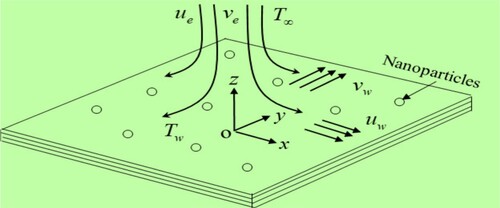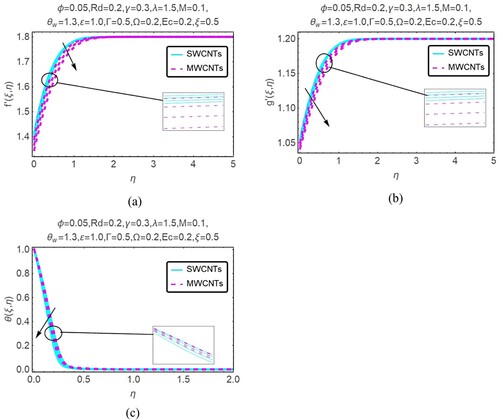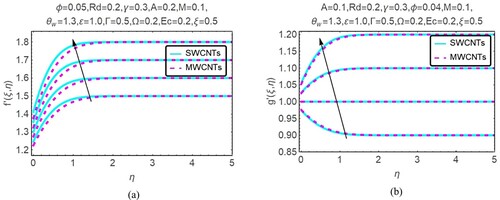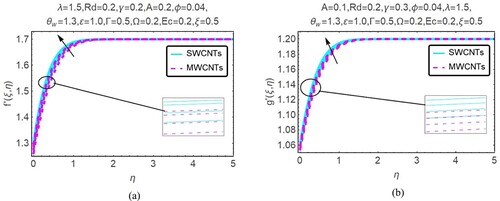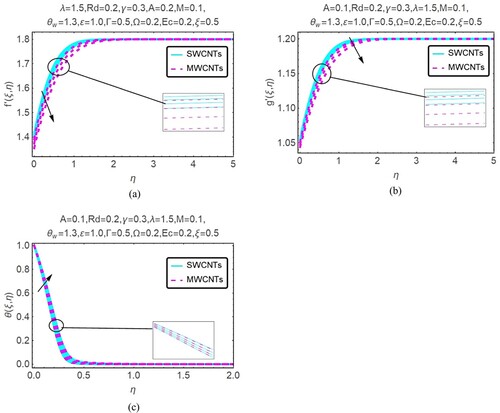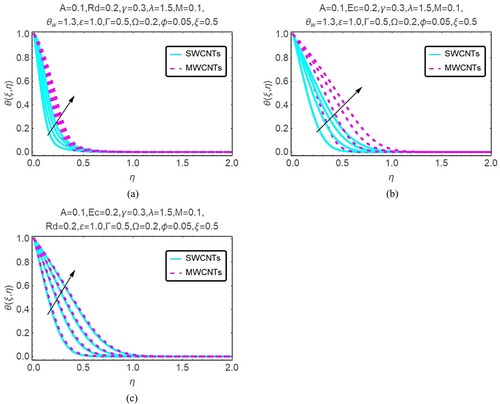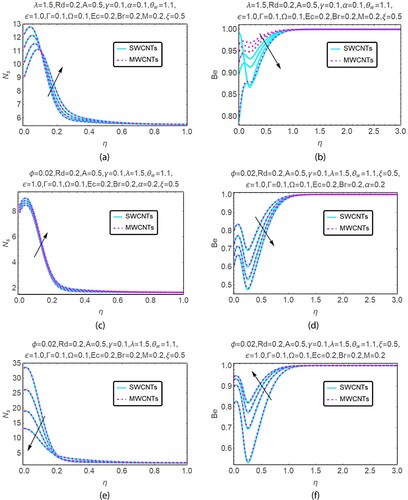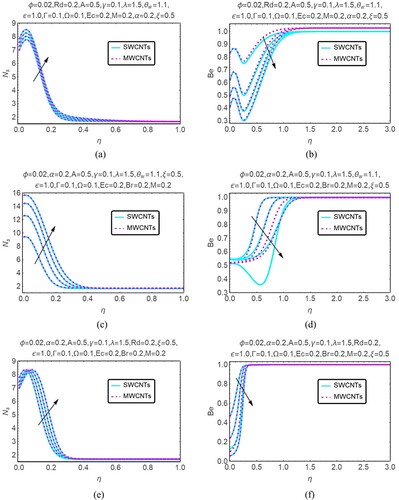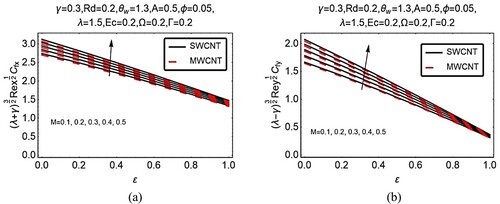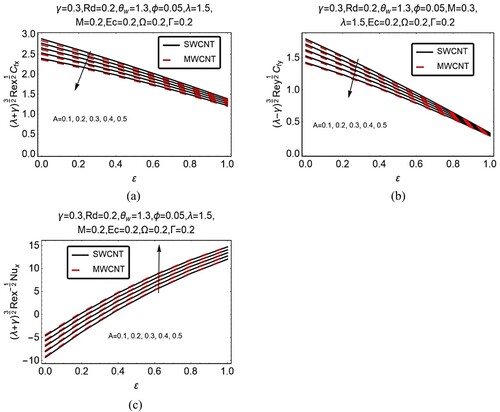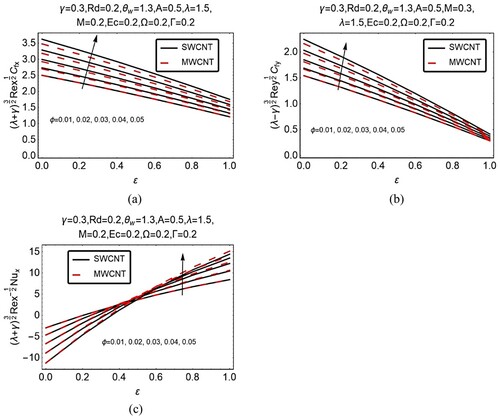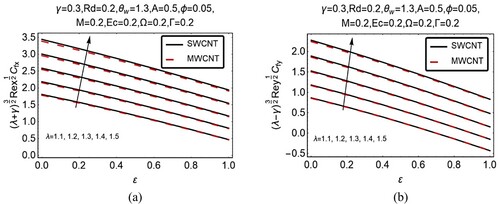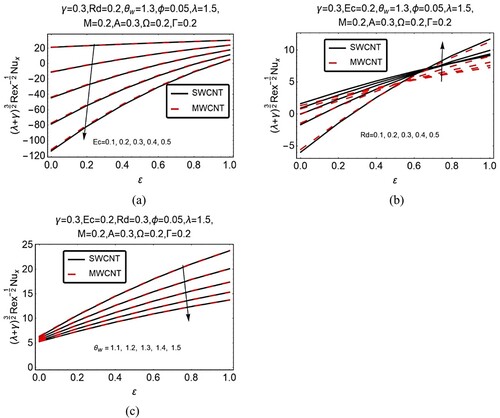 ?Mathematical formulae have been encoded as MathML and are displayed in this HTML version using MathJax in order to improve their display. Uncheck the box to turn MathJax off. This feature requires Javascript. Click on a formula to zoom.
?Mathematical formulae have been encoded as MathML and are displayed in this HTML version using MathJax in order to improve their display. Uncheck the box to turn MathJax off. This feature requires Javascript. Click on a formula to zoom.Abstract
In this study, the Yamada-Ota model is used to look for an analysis of irreversibility when there is nonsymmetric magnetohydrodynamic flow inside a nanoliquid made of carbon nanotubes (CNTs) across an unsteady three-dimensional stretching surface. In this investigation, both single- and multi-walled carbon nanotubes (SWCNTs and MWCNTs, respectively) are considered, as they are both suspended in a water solution. Anisotropic slip conditions, nonlinear thermal radiation, and an induced magnetic field are all accounted for in the model. The PDEs are changed into a group of nonlinear Equations using the non-similarity transformations and then solved by using the BVP4c program in MATLAB. The effects of important parameters like magnetic field strength, unsteadiness, nanoparticle volume fraction, slip conditions and nonlinear thermal radiation are also looked at. Increasing the nanoparticle volume percentage results in a greater velocity field for SWCNTs than for MWCNTs. The profile of entropy production exhibits an upward trend in relation to the parameters Φ, M , Br, Rd and θw , however, it has a downward trend in relation to the parameter α. The Bejan number profile shows an upward trend in the concentration of α, while showing a decline in the cases of Φ, M , Br, Rd and θw.
1. Introduction
Choi (Choi & Eastman, Citation1995) first proposed the concept of nanofluids as a scientific idea in 1995. Choi's seminal study underscored the importance of nanofluids as a pivotal class of fluids that had the ability to substantially enhance heat transfer rates. Nanofluids are generated by the dispersion of nanoparticles composed of different metals inside a fluid medium. Thus far, a diverse array of nanoparticles and base fluids have been used in scholarly publications. There are many kinds of nanoparticles in these groups, such as magnetic nanoparticles, polymer-based nanoparticles, carbon nanotubes, liposomes that work as tiny quantum dots, metal nanoparticles, dendrimers, polymer-based nanoparticles, and many more. The basic fluids that are often used include water, oil, or ethylene glycol. Metallic nanoparticles include a diverse range of minerals, including alumina, carbides, copper, metal oxides, and nitrides. On the other hand, non-metallic nanoparticles cover graphite and the well-known carbon nanotubes. Various mixtures of nanoparticles and base fluids have been investigated by researchers. Research that was carried out by Jamshed and colleagues (Jamshed et al., Citation2021) investigates the features of nanofluid flow and heat transfer when the nanofluid is exposed to a surface that has attributes that make it slippery. Nevertheless, a conclusive determination of the combination that provides the greatest enhancement in heat transfer rates remains elusive (Mishra et al., Citation2023), (Abbasi & Ashraf, Citation2023), (Adnan & Ashraf, Citation2023), (Adnan, Citation2022).
In addition to the debate that took place before, it is essential to emphasize the distinct importance that is associated with every kind of nanoparticle and base fluid. In this investigation, carbon nanotubes (CNTs) served as the nanoparticles that were suspended in water. Water was used as the base fluid. CNTs are cylinder-shaped structures that have elongated, tubular geometries and generally measure between one and two nanometers in diameter (Ganie et al., Citation2023, Citation2023). According to Choi and Zhang's (Choi & Zhang, Citation1995) argument, the best types of CNT are precisely those in which carbon atoms form a hexagonal network. The shapes that result from such networks tend to be seamless, hollow cylinders. The discovery of carbon nanotubes (CNTs) was made by Japanese scientist Sumio Iijima (Iijima, Citation1991) in 1991. He was the first to find multi-walled nanotubes. It was, in fact, far less than two years before researchers discovered single-walled nanotubes. This is something of an achievement all by itself. With these excellent nanostructures, great thermal conductivity, incredible mechanical strength, and resistance to corrosion, CNTs are attracting a vast amount of research interest from lots of scientists. Their remarkable properties have meant that CNTs can be used in a large variety of sectors, from photovoltaic cells to carbon nanotube transistors and lithium-ion batteries through chemical sensors. The two basic forms of CNTs that are used in theory and experiment alike are single-walled carbon nanotubes (SWCNTs) and multi-walled carbon nanotubes (MWCNTs). As a case in point, Kamali and Binesh (Kamali & Binesh, Citation2010) implemented numerical analysis on the rise of heat conduction for non-Newtonian nanofluids containing CNTs. Heat transfer with single MWCNTs It was the metachronal beating of cilia that Noreen and Khan (Akbar & Khan, Citation2014) studied in their research. The study done by Aman et al. (Aman et al., Citation2017) looked at heat transfer enhancement using Maxwell nanofluids, in which a suspension of carbon nanotubes (CNTs) was dispersed inside four different kinds of molecular liquefaction products. Zhang was interested in the heat transfer capabilities of CNTs membranes and did experimental studies on them. Using core flooding methods, Soleimani et al. (Soleimani et al., Citation2018) evaluated the effect that nanofluids based on carbon nanotubes would have on the amount of oil that could be recovered.
The exploration of the flow of nanofluids in a stagnation zone has become a captivating field of study owing to its extensive range of practical applications. An exemplary instance within engineering applications pertaining to stagnation flow is the plane counter-flow jet (Zheng et al., Citation2012). The use of stagnation point flow has been seen in both the polymer sector and extrusion operations (Islam et al., Citation2023). The first documented identification of a precise solution for stagnation-point flow may be traced back to the year 1911, with credit given to Hiemenz (Hiemenz, Citation1911). Following this, Homann (Homann, Citation1936) made noteworthy contributions by commencing the classical investigation of 3D axisymmetric stagnation point flow. Howarth (Howarth, Citation1951) made significant contributions to the topic by investigating the presence of non-axisymmetric 3D flow in the vicinity of the stagnation area. Several scholars, including Mahapatra and Gupta (Mahapatra & Gupta, Citation2002) as well as Wang (Wang, Citation2008) have conducted investigations into several facets of stagnation point flow issues while considering the presence of no-slip boundary conditions.
Nevertheless, in several situations, it becomes essential to consider the slip phenomenon. This issue has significant importance in several scenarios, including but not limited to extremely hydrophobic nano surface liquid flow, surfaces characterized by roughness or grooves, and internal flow of rarefied gases (Zainal et al., Citation2020). Slip boundary conditions are necessary in several industries and applications, such as fluid flow over numerous surfaces, rarefied fluid issues, and the polishing of mechanical heart valves. The introduction of slip boundary conditions was pioneered by Navier (Navier, Citation1827) and Maxwell (Maxwell, Citation1879) in conjunction with the advancement of linear slip boundary conditions. In a study done by Wang (Wang, Citation2013), an investigation was carried out to scrutinize the impacts of anisotropic slip on the three-dimensional stagnation-point flow. The flow was analyzed in two orthogonal directions, each characterized by distinct slip coefficients. There is no end of scholarly literature discussing the multiple applications in different fields and technologies based on anisotropic slip, including hydrophobic porous surfaces (Pearson et al., Citation2016). Anisotropic slip phenomena have received more attention in recent years. Hafidzuddin et al. (Hafidzuddin et al., Citation2017) in their study examine the significance of anisotropic slip for three-dimensional Homann stagnation point flow. When isotropic slip was incorporated in the Raees et al. (Raees et al., Citation2016) study of a nanofluid containing both microorganisms and nanoparticles, they investigated the characteristics of stagnation flow. Rashad (Rashad, Citation2017), in a study, examined the properties of unstable three-dimensional flow across an inclined stretched surface. Furthermore, the effects of convective boundary conditions and slip-on flow anisotropy were taken into account in this study. Al-Balushi et al. (Al-Balushi et al., Citation2017) studied the characteristics of three-dimensional axisymmetric stagnation point flow under different temperature conditions, even taking into account the existence of anisotropic slip when doing so. A great body of research exists, for example, by Mahmood et al. (Mahmood et al., Citation2023, Citation2023), with many studies on the analysis of stagnation point flow (including slip conditions).
Scholarly interest has been focused on studying boundary layer flows resulting from surface contraction or stretching. Heat transfer and flow characteristics caused by surfaces stretching or contracting have been used in many technical situations, such as the equipment used in conveyor systems and the aerodynamic extrusion of plastic sheets (Adnan et al., Citation2022). Sakiadis (Sakiadis, Citation1961) highlighted the difference between the boundary layer developed on a surface with limited length and the boundary layer created on a solid surface. In their study, Mahabaleshwar et al. (Mahabaleshwar et al., Citation2016) examined the characteristics of magnetohydrodynamic (MHD) nanofluid flow in the vicinity of a stretching or shrinking surface while considering the influence of suction effects. Madhu et al. (Madhu et al., Citation2017) investigate the phenomenon of unstable magnetohydrodynamic boundary layer flow in a non-Newtonian Maxwell nanofluid across a stretched surface. Their study incorporates the consideration of thermal radiation effects. The objective of Manjunatha et al. (Manjunatha et al., Citation2019) is to examine the augmentation of heat transmission by modifying basic fluid parameters within the framework of free convection. The objective is accomplished by the use of suspended hybrid nanofluids in boundary layer flow.
Magnetohydrodynamics (MHD) is an academic discipline that investigates the behaviour of electrically conducting fluids, with a particular focus on plasmas or liquid metals where the magnetic field assumes a vital and ever-changing function. The phenomena in issue include the production of electric currents and, after that, the induction of a Lorentz force that operates in a manner that is diametrically opposed to the magnetic fields. Takhar and co-authors (Takhar et al., Citation2002) studied the non-similar boundary layer flow of an electrically conducting, viscous, incompressible fluid over a moving surface inside a rotating fluid. A magnetic field and Hall currents are taken into account in this study. The Joule effects are examined by Krishna et al. (Krishna et al., Citation2019) within the framework of magnetohydrodynamic (MHD) mixed convective flow. The investigation centres on the motion of a viscous, incompressible, electrically conducting fluid across a porous plate that is indefinitely vertical and takes Hall effects into account. Natural convection from a semi-infinitely angled flat plate is used to pose the issue of coupled heat and mass transport by Chamkha and co-authors (Chamkha & Khaled, Citation2001). This model takes into consideration the effects of both internal and external magnetic fields on heat production and absorption. Kumar and his co-authors (Kumar et al., Citation2019) analyze the steady-state optically thin-film flow across a vertical plate of an incompressible electrically conductive fluid. In the inquiry, these factors are considered: magnetic-hydrodynamic mixed convection, heat radiation, and viscous dissipation. The problem of thermophoresis and hydromagnetic flow involving heat and mass transfer was considered by Chamkha and Issa in (Chamkha & Issa, Citation2000) for a semi-infinite flat permeable surface. In the study by Tiwari and colleagues (Tiwari et al., Citation2017) on MHD processes in connection with the motion of CNTs through a porous medium, they took account of radiation effects. Hayat and co-workers (Hayat et al., Citation2017) have conducted research to examine how single-walled carbon nanotubes (SWCNTs) and multi-walled carbon nanotubes (MWCNTs) affect the boundary layer flow of viscous fluids in a dirty environment.
Entropy generation is an important concept that comes directly from the basic principles of second-law thermodynamics, which must be considered in any analysis of actual real-life systems. Real-world conditions make it nearly impossible to attain optimal situations without energy dissipation, such as heat or friction. As a consequence, professionals in various fields tend to focus on minimizing energy losses in systems. Analyzing entropy generation is a beneficial device to determine how losses arise in the course of thermal processes, assess system performance, and seek some desired optimum efficiency. Entropy generation analysis opens up different applications, including electrical devices, the heating and cooling industry, biological systems, and even chemical processing. In heat exchange systems and moving fluids, Bejan's (Bejan, Citation1979) groundbreaking research introduced the concept of entropy creation. Thereafter, a large number of academics have thoroughly studied the topic, namely, how entropy is formed in fluid and thermal transportation processes. Rashidi and Freidoonimehr (Rashidi & Freidoonimehr, Citation2014) conducted an investigation to elucidate the phenomenon of entropy generation in magnetism flow through porous media. The process of entropy formation in the flow of a Newtonian nanofluid caused by curved, flexible sheeted nanofluids was explored by Hayat et al. (Hayat et al., Citation2021). The factors influencing this procedure were a wide range, including the generation or intake of heat, reconciling nanoparticles and their aggregation problems, and using suction to feed. Khadija and colleagues performed research to find out what effect different forms of nanoparticles had on the creation of entropy in a water-alumina nanofluid (Rafique et al., Citation2023; Rafique et al., Citation2023). When the nanofluid passed through a permeable magnetohydrodynamic stretching sheet, we found that it moved at rates described by a quadratic relationship. To see how entropy affects the dynamics of an unstable slip flow of a viscous fluid that is subject to hydromagnetic forces as it moves over an exponentially growing sheet, Haider and his colleagues (Haider et al., Citation2020) did research. Sibanda and colleagues (Sibanda et al., Citation2022) studied entropy production within the scope of their research. They determined how closely this relates to the Bejan number. They focused on the wave motion of a viscoelastic, incompressible nanofluid that moved over an exponential sheet. Shit et al. (Shit et al., Citation2017) studied the characteristics of an unstable boundary layer magnetohydrodynamic flow and convective heat transfer on an exponentially stretched surface that is immersed in nanofluids. The study looked at the effects of thermal radiation and entropy generation. Jamshed et al. (Jamshed et al., Citation2021) examine the unsteady flow behaviours of a non-Newtonian Casson nanofluid, as well as its entropy and heat transport properties, in their study.
This study will perform a detailed analysis of the entropy production phenomenon for a three-dimensional MHD stagnation point flow across a stretched surface with nonlinear thermal radiation. This research will use a nanofluid to examine the anisotropic slip characteristics of suspended carbon nanotubes (CNTs). According to the Yamada-Ota concept, carbon nanotubes (CNTs) suspended in water () are used as a model of nanofluid for this investigation. This nanofluid contains two types of nanoparticles: single-walled carbon nanotubes (SWCNTs) and multi-walled carbon nanotubes (MWCNTs), both suspended in a water-based medium. This unique combination of thermophysical properties and rheological behaviours is predicted to enhance heat transfer characteristics. This highly intelligent working fluid, with several unique characteristics of its own, has drawn the interest of a number of researchers eager to find potential applications for it in thermal conductivity fluids. It is also unique in its identification of different solutions. They are achieved with non-similarity transformations and a localization technique that takes into account both first and second truncations. The strategies are designed to transform the flow model into a system of ordinary differential (ODE) equations that can be solved numerically using BVP4c. This paper looks at the graphical representation of how some factors affect heat transfer flow characteristics. It also has numerical verification, which rechecks the findings by comparing them with known results in the present literature.
Motivation: The use of the Yamada-Ota Model in this area, spanning all facets of single-wall nanotubes (SWCNTs) and multi-wall nanotubes (MWCNTs), arises outright from a need for an integrated understanding, as well as scrutiny, of the complex fluid dynamics and heat transfer phenomena occurring within these types. This model is designed to deepen our understanding of the behaviour of single-walled carbon nanotubes (SWCNTs) and multi-walled carbon nanotubes (MWCNTs). We will consider factors such as the volume percentage of nanoparticles, the unsteadiness factor and force in magnetism. With this model, we can completely study these nanotubes, so both academia and perhaps the marketplace benefit.
Applications: The study of unsteady stagnation point flow on a nonlinear radiative stretching surface in three dimensions, while taking entropy generation into account, is very useful in many fields. One possible use is in the design and optimization of advanced cooling systems for aerospace vehicles, such as hypersonic planes or re-entry spacecraft.
1.1. Problem formulation
Consider a hypothetical dynamic flow system that encompasses a three-dimensional non-axisymmetric Homann stagnation point. In this research configuration, a nanofluid including carbon nanotubes (CNTs) is used, with the flow taking place on a stretched sheet positioned inside the plane. To provide further clarification, it is important to note that the system under consideration is defined using
and
coordinates. The
axis is employed to indicate the horizontal direction, while the
and
axes are positioned inside the plane
, as visually shown in Figure .
The following assumptions are made:
The surface temperature, represented as
, undergoes expansion and contraction in both the
and
-directions because of velocities
and
, respectively.
The ambient surroundings exhibit a consistent and homogeneous temperature, denoted as
.
A perpendicular transverse magnetic field, denoted as
, is applied to the surface, with
representing the magnitude of the magnetic field. The magnetic Reynolds number is thought to be adequately small, thereby justifying the neglect of any induced magnetic field effects. Additionally, we assume that there is no electric field.
Additionally, any possible influence of nanoparticle aggregation on the thermophysical characteristics is disregarded. This assumption is based on the premise that the suspended nanofluid consisting of carbon nanotubes (CNTs) is synthesized in a manner that ensures the steady integration of the base fluid and nanoparticles.
Flow is laminar.
The consideration of anisotropic slip situations is undertaken.
The analysis considers the effects of viscous dissipation, joule heating and nonlinear thermal radiation.
Yamada-Ota Model is considered.
Given the aforementioned assumptions, The derivation of the governing equations for the boundary layer may be accomplished in the following manner (see Ganie et al., Citation2023; Zainal et al., Citation2020):
(1)
(1)
(2)
(2)
(3)
(3)
(4)
(4)
The symbols and
stand for the velocity components in the
and
directions, respectively. Roseland (Ganie et al., Citation2023, Citation2023) has presented the following equation to represent the thermal radiative component:
(5)
(5) The symbol ‘
’ is used to represent the mean absorption coefficient, whereas the symbol ‘
’ is used to designate the Stefan-Boltzmann constant. By substituting Equation (5) for Equation (4), we get the updated energy equation.
(6)
(6) Subsequently, the boundary conditions encompass:
(7)
(7) In this context, the variable ‘
’ denotes the strain rate, while ‘
’ signifies the shear rates linked to the flow at the stagnation point.
and
are velocity slip factor. Additionally, the symbol ‘
’ indicates the temperature of a nanofluid that contains carbon nanotubes (CNTs).
The thermophysical characteristics of nanofluids, including carbon nanotubes, including both single-walled CNTs and multi-walled CNTs, have been comprehensively documented in Table , as reported by Yamada and Ota (see Ganie et al., Citation2023, Citation2023). In the present context, the symbol is used to denote the volume fraction of nanoparticles.
represents the heat capacity, while
and
refer to the capacitance heating characteristics of the base fluid and CNTs nanoparticles, respectively. Lastly,
and
represent the thermal conductivities of the base fluid and CNTs nanoparticles, respectively. The parameters denoting the physical attributes of carbon nanotubes (CNTs), namely their length and radius, are conventionally denoted as
and
, respectively. The fluid and the nanoparticles, which are single- and multi-walled carbon nanotubes, are shown together in Table along with their respective thermophysical parameters. Additionally, the table includes the features of the underlying fluid, namely water.
Table 1. Nanofluids, such as single- and multi-walled carbon nanotubes (SWCNTs and MWCNTs, respectively), may be used to demonstrate their physicochemical properties (Ganie et al., Citation2023, Citation2023).
Table 2. Both the base fluid and the carbon nanotubes (both single- and multi-walled) have thermophysical properties that must be taken into account (Ganie et al., Citation2023, Citation2023).
Following this, non-similarity variables are defined as (see Farooq et al., Citation2020);
(8)
(8) Equations (8) translate equations (1–3, 6) that account for the length and radius of carbon nanotubes as part of the energy equation.
(9)
(9)
(10)
(10)
(11)
(11) When the boundary conditions from equation (7) are considered, the following change takes place:
(12)
(12) As seen in the equations, the variable A denotes the parameter of unsteadiness and is mathematically defined as
. The fluid's deformation is proportional to the square root of the stress surface's velocity, or
. The ambient fluid shear rate is represented by
. Magnetic parameter is represented by
,
represents the radiation parameter. It is essential to emphasize that the occurrence of nonlinear radiation effects is contingent upon the value of
, whereas linear radiation effects are seen when
. Dimensionless velocity slip parameters are
and
Prandtl number is represented by
.
is Eckert number. The stretching parameter is often represented by the symbol
. A positive value of
indicates the existence of a stretching sheet. This study focuses on the relevant variables, namely the coefficients of skin friction in the
and
directions
and
, together with the local Nusselt number
. These variables are defined as follows:
(13)
(13) The practical indicators of relevance include the dimensionless coefficient of skin friction in both direction and the local Nusselt number, which are represented as:
(14)
(14)
1.2. Local non-similar solution
Sparrow and Yu (Sparrow & Yu, Citation1971) first proposed the local non-similarity approach for boundary layer issues. Many researchers (e. g Farooq et al., Citation2020) have used this technique on different shapes, resulting in reliable solutions for boundary layer issues that are not identical. An appealing feature of the local similarity model is the ability to get a solution at a given place along the stream without requiring computations to be performed at upstream sites. The local similarity model diverges from all dissimilar border layers to different degrees. The local, non-similar solution is distinguished by its simplicity and directness, both in its idea and execution, which makes it particularly attractive. The work included examining the effects of different physical factors on various geometries by analyzing the velocities of boundary layers in local, non-similar issues. Some examples of these conditions are mass transfer, Howarth's delayed flow, cylinders, and flat plates with uniform surfaces.
Researchers often apply the concept of local similarity to address issues arising from dissimilar boundary layers. In this environment, it is supposed that the values on the right side of equations (9–10) are negligibly tiny, giving them a good reason to be approximated as zero. Using this method can reduce the complexity of equations to ordinary differential ones, making computation more efficient. The study describes and demonstrates a technique for detecting an incomparable boundary layer. Local non-similarity starts with a variety of techniques, such as local truncation and perturbations, to turn non-linear partial differential equations into ordinary differential equations (ODE). This study uses the local truncation approach. First- and second-order truncations are both part of local truncation. After applying these truncations, we create ordinary differential equations (ODEs), which are then used to find solutions using the BVP4c technique.
First Order Truncation
The terms that include the equation may be disregarded when
. Therefore, the terms on the right-hand side of Equations (9–11) are excluded. Consequently, we acquire:
(15)
(15)
(16)
(16)
(17)
(17)
Equations (15–17) denote a set of ordinary differential equations (ODEs).
Second Order Truncation
In order to perform truncation at a more advanced level, the following additional functions are introduced:
(18)
(18) During the initial stage, the equations (9–11) for the functions
and
, respectively, stay the same.
(19)
(19)
(20)
(20)
(21)
(21)
The model is subject to the corresponding boundary conditions.
(22)
(22) Regarding the variable
the equations (19–21) are differentiated to provide additional equations (23–25) for
and
along with their respective boundary conditions, which are as follows:
(23)
(23)
(24)
(24)
(25)
(25) At this level of truncation, the variables
and
, together with their derivatives, were ignored with respect to
to achieve precise findings.
2. Entropy generation
The principle of entropy is used to quantify irreversibility in a system, and it is used here to emphasize the fact that total heat transfer is impossible while work is being done. This further demonstrates why entropy creation is so crucial to this field of research. This leads to an expression for the dimensional form of entropy generation, which is (Mahmood et al., Citation2023):
(26)
(26) The dimensionless entropy generation number, denoted as
, may be mathematically expressed as follows (Mahmood et al., Citation2023):
The determination of the typical rate of entropy formation, represented as
, is presented as:
The dimensionless entropy generation number
may be obtained by using a similarity transformation (8) to get the characteristic rate of entropy generation.
(27)
(27) The dimensionless quantities considered in the above equations are:
(28)
(28) denote the Brinkman number and temperature difference respectively.
The Bejan number quantifies the ratio of heat transport to total entropy in a given system (see Mahmood et al., Citation2023):
(29)
(29) When the Bejan number (
) is equal to 1, it indicates that the dominant factor contributing to irreversibility is heat transport. In contrast, in cases where the value of
is zero, the occurrence of irreversibility may be attributed largely to the presence of fluid friction. When the
number is equal to 1/2, it indicates a scenario in which both fluid friction and heat transfers play a substantial role in the generation of irreversibility.
3. Numerical procedure with code validation
Single- and multi-wall carbon nanotube-related non-linear ordinary differential equations are difficult and time-consuming to solve. In such situations, analytical answers are sometimes unavailable or impracticable to implement. Thus, numerical techniques are preferred over other approaches when dealing with such models. The bvp4c solver, which is a powerful tool in the MATLAB programme, is often used for the solution of nonlinear ordinary differential equations. The equations presented above encapsulate the reduced equations that arise from boundary layer flow issues. To solve Equations (9–11), the numerical solutions were found by using the bvp4c function integrated inside MATLAB, while ensuring compliance with the boundary conditions as outlined in Equation (12). In the present situation, the use of the three-stage Lobatto IIIa formula is carried out via the implementation of a finite difference code referred to as bvp4c. The method described is often referred to as collocation, in which the collocation polynomial guarantees a solution that is continuous up to the first derivative (-continuous) and has an accuracy of fifth order. It is important to mention that the bvp4c function solely deals with first-order differential equations and does not provide support for second-order equations. As a result, the equations numbered (9–11) were transformed into a set of first-order differential equations to ensure compatibility with the bvp4c method as shown in Figure . Hence, to ensure compatibility between Equations (9–11), they are converted into a system of first-order differential equations. In order to get the necessary degree of precision, it is important to create an initial approximation for the starting mesh point and ascertain the magnitude of the step size, represented as
. In the present investigation, the required value for the boundary layer thickness is denoted as
. The chosen step size is
= 0.01, and a relative error tolerance of
is used. The preliminary estimations are dependent on the parameter values used in the calculation.
Comparative analysis with the data shown by Ganie et al (Ganie et al., Citation2023), as shown in Table , has confirmed the validity of the findings in this study. The results obtained from this study exhibit a strong correlation with the findings of other investigations, suggesting a notable degree of congruity. Based on the results presented, the authors are confident that the suggested mathematical model can help with thorough investigations of fluid flow and heat transfer assessments for the current topic.
Table 3. The computation of the produces outcomes that are dependent on certain values of
when
and
.
4. Results and discussion
A range of parameter values was selected in order to methodically examine the phenomena of entropy creation, heat transfer, and flow dynamics. The current issue encompasses several significant factors, including the volume percentage of nanoparticles (), the parameter representing unsteadiness (
), and the magnetic parameter (
), stretching parameter
, Eckret number parameter
fluid shear rate parameter
fluid deformation parameter
radiation parameter
, temperature ratio parameter
Brinkmann number parameter
and velocity slip parameters are
and
)
Furthermore, the impact of these factors on fluid motion, skin friction coefficient, entropy generation, Bejan number, temperature, and heat transfer profiles is shown via various graphs. For the purpose of doing the calculations, we used the following ranges of values: ,
,
,
and
. Ensuring a consistent Prandtl number (
) throughout the investigation, is a crucial aspect that underscores the importance of the results. The selection of these values is derived from literature (see Ganie et al., Citation2023, Citation2023; Zainal et al., Citation2020), taking into account the satisfaction of the far-field boundary requirements (12).
5.1. Velocity and temperature profiles for several engineering parameters
In Figure (A–C), the impact of various values of is depicted, showing their effects on the
and the
within suspended nanofluids that include both SWCNTs and MWCNTs. The velocity profiles exhibit a steady reduction with increasing
, as shown in figures (A and B). Moreover, the images provide evidence that when the parameter
increases in magnitude, the velocity profiles become more distinct and prominent. The relationship between variable
and the velocity profiles provides an opportunity to investigate the specific impacts of
on the
and
inside the CNTs-suspended nanofluid, as well as its influence on the overall thickness of the boundary layer. The present inquiry is made possible by our capacity to evaluate the impact of variable
on the thickness of the layer. This visual representation demonstrates the influence of variable A on the profile shown in Figure (C), which may be referenced in this context. Figure (C) illustrates an adverse relationship between the variables, indicating that an elevation in the values of
is associated with a reduction in
in the nanofluid, including both SWCNTs and MWCNTs. This observation suggests a decrease in the temperature gradient. This discovery is logically consistent when considering the phenomenon of particle differences being magnified under conditions of unsteady flow. The observed increase in variability results in a more constrained temperature distribution, enhancing the fluid's heat absorption rate. Considering these consequences, it is essential to underscore the significance of turbulence and thoroughly contemplate its practical ramifications prior to making judgments based on these results.
Figure (a, b) illustrates how changing the parameter influences the velocity profiles, more particularly
and
, in the
and
directions for suspended nanofluids that include CNTs (SWCNTs/water and MWCNTs/water). We can see possible changes in the profiles of
and
because of the interaction between the surface strain rate and the parameter of the fluid in Figures (a and b). These changes are shown in the figures. Because of the presence of a certain parameter in the fluid, these fluctuations may take place. The fact that the strain rate at the surface is not identical to the strain rate parameter of the fluid makes it possible for these variations to take place. According to the results of the experiments, it is now clear that the velocity profiles are becoming closer and closer to the circumstances described in equation (12) for the far-field boundary. This can be deduced from the fact that the far-field border is getting closer. Even if the thickness of the momentum barrier were to decrease, it would be simpler to maintain a larger velocity gradient if the value of the parameter were increased to a higher level. This is still the case even when the value is held steady.
In Figures (a and b), we see the influence of magnetic parameters on
and
for suspended nanofluids, including CNTs (SWCNTs/water and MWCNTs/water). These nanofluids are made up of MWCNTs and SWCNTs, respectively. These data make it abundantly evident that the
has a substantial impact on the flow of fluid across the stretched sheet. An increase in the magnetic parameter,
, causes a flow delay, which ultimately results in a thinner boundary layer in both directions, as seen in Figures (a and b). This phenomenon can be seen in both figures. Because of this, the values of
and
are found to be significantly increased.
Figures (a) through 6(c) illustrate the influence that changing values of have on temperature profiles as well as velocity profiles in both directions. The data establishes beyond a reasonable doubt that when the value of
upsurges, there is a discernible drop in the velocity profiles. The density of the nanofluid rises in response to an upsurge in the value of the parameter
. Because of this shift in density, the flow velocity profiles are altered, which ultimately results in a slower flow rate in both the forward and reverse directions. Figure (c) shows more evidence that supports the idea that when the value of
goes up, the temperature of the carbon nanotube-containing nanofluid (both SWCNTs/water and MWCNTs/water configurations) goes up. This rise may be traced back to an expansion of the thermal boundary layer as well as an enhancement in the heat conductivity of nanofluids that include carbon nanotubes. These two phenomena contribute to the overall increase in the thermal conductivity of the system. These two aspects are connected to one another. The existence of nanoparticles makes it easier to disperse thermal energy in a more effective manner, which has benefits for the functioning of natural processes. As a consequence, a larger concentration of nanoparticles has the potential to lead to a greater creation of heat, which in turn has the potential to result in increased temperatures. This suggests that it may be possible to manage the temperature of nanofluids that include carbon nanotubes (both single-walled and multi-walled) by altering the concentration of nanoparticles that are contained within the fluid. This is true whether the nanotubes are single-walled or multi-walled.
An investigation of the influence that has on
may be seen in Figure (a). It is interesting to observe that the value of
grows as
increases, and this holds true for both SWCNT and MWCNT. Because the Eckert number has increased, there is now a higher force of drag acting between the various fluid components. As a direct consequence of this, a greater quantity of heat is produced, which in turn causes an expansion in the temperature gradient. Both Figure (b and c) illustrate the effect that the radiation parameter
and the temperature ratio parameter
have on the value of
. We can see the impact that changing
has on
by looking at Figure (b). The temperature profiles of carbon nanotubes (CNTs), which include single-walled carbon nanotubes as well as multi-walled carbon nanotubes (MWCNTs/water), consistently and concurrently rise as the radiation parameter
for the stretched sheet rises. This is the case regardless of whether the nanotubes are single-walled or multi-walled. With increased values of the radiation parameter
, there is a clear trend toward an improvement in both the temperature distribution and the accompanying boundary layer thickness. It should come as no surprise that the effect of thermal radiation results in an increase in surface heat flow. This has resulted in a rise in temperature inside the boundary layer area, which is a direct consequence of the situation. One explanation for this that has been suggested is an acceleration of the rate at which heat conducts. An increase in the value of this radiation parameter causes a larger portion of heat to be transported from the stretched sheet to its surroundings through radiation. With this additional mechanism of heat transfer, the surface temperature of CNTs rises. Looking at the data shown in Figure (c), we study how different values of the temperature ratio parameter
affect the thermal profile, or
. Under some circumstances, an increase in the
parameter may result in a larger thermal energy transfer from the stretched sheet to the CNTs. Because of this increase in the amount of energy that is being input, there is a chance that the temperature profile of the CNTs may rise. In the present subsection, it is seen that the velocity profile of SWCNTs/water is greater, whereas the temperature profile of MWCNTs/water is evident.
5.2. Entropy generation and Bejan number for several engineering parameters
In this subsection, the influence of several parameters, namely and
, on entropy generation (
) and the Bejan number (
) in suspended nanofluids including SWCNTs/water and MWCNTs/water can be deduced from the analysis of Figures and . Figure (a) shows how changing the
affects the entropy generation profile. Figure (b), which shows the related Bejan number profile, shows how the
affects the Bejan number profile. As the
goes up in SWCNTs/water and MWCNTs/water nanofluids, the entropy generation (
) curve goes up. This can be attributed to the incorporation of a greater number of nanoparticles into the fluid, which introduces additional sources of irreversibility and entropy generation. The main reasons behind this occurrence are an increased resistance to the transfer of heat and the flow of fluid. On the other hand, the Bejan number (
) profile decreases in this situation due to the rise in
. Consequently, the thermal resistance becomes more potent, impeding the movement of heat through the substance. As a result, the Bejan number (
), which denotes the extent of thermal irreversibility in comparison to fluid friction irreversibility, diminishes. This indicates that the impact of thermal effects outweighs the influence of fluid friction effects. This discovery reveals that as the percentage of nanoparticles in the system increases, the significance of heat resistance for the overall irreversibility of the system intensifies.
The visual representations in figures (c and d) depict the impact of various magnetic parameter values () on the profiles of entropy production and Bejan number for suspended nanofluids containing carbon nanotubes (SWCNTs/water and MWCNTs/water). In Figure (c), the entropy production displays an upward trajectory as the magnetic parameter values increase, while in Figure (d), the Bejan number exhibits a declining pattern. The influence of the magnetic field on the behaviour of SWCNTs/water and MWCNTs/water suspended nanofluids can explain the observed relationship between the magnetic parameter and the entropy production profile. The single-walled carbon nanotubes (SWCNTs) and multi-walled carbon nanotubes (MWCNTs) in suspension move and have different properties depending on how the magnetic parameter is changed, in this case by making the magnetic field stronger. Under the stimulus of an intensified magnetic field, it is possible for these nanoparticles to exhibit enhanced alignment or orientation along the lines of the field. The alignment of particles in the presence of a magnetic field has the potential to result in improved heat transmission, particularly in the direction of the magnetic field. This phenomenon is often regarded as a more efficient method of heat transfer. Nevertheless, it also results in an augmented resistance to the flow of fluid that is perpendicular to the lines of the magnetic field. The enhanced alignment and resulting alteration in fluid dynamics patterns lead to an augmented production of entropy inside the nanofluid. When the magnetic parameter is augmented, the heightened alignment of nanoparticles and the consequent enhancement in heat transmission along the magnetic field lines lead to a rise in the thermal efficiency of the system. In other words, the prominence of heat transmission surpasses that of fluid friction. Consequently, the Bejan number profile exhibits a reduction, indicating that thermal effects have more significance in total entropy production compared to fluid flow effects.
Figures (e and f) show how the temperature difference parameter () affects the profiles of
and the
in SWCNTs/water and MWCNTs/water nanofluids that are suspended in water. As
goes up, the
profile goes up in figure (f) and the entropy production
in figure (e) profile goes down. These tendencies can be explained by the basic laws of thermodynamics and heat transfer. As the value of the temperature difference parameter (
) grows, it indicates a greater magnitude of temperature variation within the system. A greater temperature gradient often signifies more efficiency in the heat transfer phenomenon. The improvement in heat transfer efficiency leads to a decrease in the dissipation of thermal energy as entropy, leading to a reduction in the profile of
. The Bejan number
may be defined as the dimensionless ratio of heat transport to entropy formation. As the parameter
increases, signifying enhanced heat transfer efficiency, there is a simultaneous reduction in entropy creation. This reduction is accompanied by a heightened importance for the ratio between heat transfer and
. As a consequence, the
exhibits a natural increase because of the increased significance of the heat transfer phenomenon in comparison to entropy creation.
Figures (a and b) show how different values of the Brinkman number () affect the generation of entropy
and the Bejan number
in SWCNTs/water and MWCNTs/water systems. It is worth noting that there is a correlation between the elevation of
values and the simultaneous rise in entropy production
and fall in the Bejan number
. The observed correlation between the Brinkman number (
) and the entropy production profile for SWCNTs and MWCNTs may be attributed to the influence of
on fluid flow and heat transfer inside radiative surface. As the Brinkman number increases, it signifies an increase in the resistance of the radiative surface to fluid flow. Put simply, the system experiences higher levels of internal fluid resistance. The augmented fluid resistance leads to an elevated dissipation of energy as the fluid encounters amplified resistance while traversing the porous material. The waste of energy is concomitant with an augmentation in the formation of entropy as the irreversibility of the flow process escalates. Conversely, when the
and fluid flow experiences heightened resistance, there is a concomitant reduction in fluid flow efficiency. As a result, a greater proportion of the energy is dissipated as entropy due to the heightened fluid resistance. The rise in entropy formation, in conjunction with a decline in the overall efficiency of energy transmission, results in a fall in the Bejan number profile.
Figures (c and d) illustrate the influence of various values of the radiation parameter () on the profiles of entropy production
and Bejan number
for suspended nanofluids consisting of SWCNTs/water and MWCNTs/water. The entropy generation profile exhibits an increase as the values of the radiation parameter grow, as seen in Figure (c). Conversely, the Bejan number profile experiences a drop in Figure (d) as the radiation parameter values increase. As the value of
increases, it signifies a heightened presence of thermal radiation in the system. The augmentation of the radiation parameter (
) implies a stronger impact of thermal radiation on the process of heat transfer, resulting in an increase in entropy generation due to the additional irreversibility associated with radiation. Consequently, the profile of the Bejan number decreases as the prominence of thermal irreversibility becomes more pronounced, indicating a decrease in the efficiency of energy transfer and an amplification in the importance of energy losses as entropy within the system.
Figures (e and f) depict the influence of the on the profiles of entropy production
and Bejan number
, respectively, for suspended nanofluids of SWCNTs/water and MWCNTs/water. The
profile in figure (e) exhibits an increase as the
values rise, whereas the
profile in figure (f) demonstrates a reduction. The fact that the entropy production profile grows as the temperature ratio parameter goes up for nonlinear radiation surfaces and the Bejan number profile goes down for SWCNTs/water and MWCNTs/water can be explained as follows: When the temperature ratio parameter goes up, it means that the difference in temperature between surfaces and the fluid around them is getting bigger. This makes entropy production go up because thermal irreversibility is getting worse. As thermal irreversibility gets stronger, the Bejan number profile goes down. This shows that the efficiency of energy transfer is getting worse, and that the system is paying more attention to energy loss as entropy.
5.3. Engineering quantities (Skin friction and Nusselt number)
In this subsection, we have examined the influence of several emerging traits on engineering factors, namely skin friction and Nusselt number. Engineering characteristics such as skin friction and Nusselt number are of paramount importance in the understanding of fluid dynamics and heat transport. Engineers do calculations on these values to optimize a range of systems in actual applications. In the context of aircraft wing design, engineers engage in the analysis of skin friction with the objective of reducing drag and optimizing lift. The Nusselt number plays a crucial role in the analysis of heat exchangers as it aids in the evaluation of the heat transfer rate, hence influencing the dimensions and effectiveness of the heat exchanger.
Figures (a and b) depict the influence of velocity slip parameters and
with the stretching
parameter's effect on skin friction in both directions
for suspended nanofluids of SWCNTs/water and MWCNTs/water, respectively. As the velocity slip parameters (
and
) goes up in both direction on a stretching surface, the skin friction profile goes down. This can be explained by considering the effects of slip conditions and stretching effects in the field of fluid dynamics, especially when looking at flows close to a solid surface. The augmentation of the velocity slip parameter (
and
) near a stretched surface in both direction results in the improvement of slip conditions, thereby facilitating enhanced fluid mobility in the vicinity of the surface. The decreased resistance to motion results in a decline in the skin friction profiles, since the slip effects cause a reduction in shear stress created at the surface.
Figures (a and b) show how the magnetic parameter () affects the skin friction coefficients
and
. This greatly influences the flow of fluid around the stretched sheet. When the magnetic parameter
increases, there is a notable increase in the skin friction coefficients on both the
and
axes. The occurrence of this phenomenon may be attributed to the existence of the Lorentz force, which serves as an impediment to the flow of fluid. The Lorentz force induces alignment between the magnetic and electric fields inside the fluid, leading to a slowdown of the fluid flow. As a consequence of this, the drop in velocity results in a lessening of the thickness of the boundary layer in both directions when the
number is increased. As a result, this decrease leads to an augmentation in both
and
.
Figure (a–c) illustrates the impact of different values of in conjunction with
on the
in both the
and
directions, as well as the profiles of the
. The data presented provides insights into the behaviour of the nanofluid containing carbon nanotubes (namely, single-walled carbon nanotubes and multi-walled carbon nanotubes) in relation to the variables
, and
under unsteady conditions, as influenced by changes in parameter
. Figures (a and b) show that there is a clear relationship between changes in the
parameter and the changes in the
and
components of the skin friction coefficient that result from those changes. The augmentation of parameter
leads to the enlargement of the boundary layer, thus causing a decrease in the velocity gradient across the permeable sheet. As a result, both
and
exhibit a reduction. Furthermore, the inclusion of ϕ (nanotube volume fraction) may potentially lead to a reduction in
and
because of the heightened viscosity of the nanofluid generated by the attendance of both SWCNTs and MWCNTs on the permeable surface. Moreover, the findings shown in Figure (c) demonstrate that with a rise in parameter
, there is a corresponding increase in the
value, which represents the rate of heat transfer on the permeable sheet. This observation indicates that the use of
leads to a substantial enhancement in heat transfer. Nevertheless, it is crucial to emphasize that the authors recognize the potential variability of these effects when many control factors are considered in different settings.
Figures (a–c) depict the influence of the parameter on variations in the
and
for nanofluids comprising carbon nanotubes (CNTs) distributed in water, alongside the
. As the parameter
rises, there is a noticeable increase in the
and
in both the
and
- directions, as seen in Figures (a and b), respectively. Additionally, the
value also exhibits an increase, as indicated in Figure (c). The results are visually shown in the accompanying figures. The underlying explanation for this behaviour may be attributed to the relationship between nanoparticle concentration and the creation of kinetic energy. Specifically, a higher concentration of nanoparticles results in a larger increase in kinetic energy than a lower concentration of nanoparticles. Therefore, the increased kinetic energy allows faster heat transfer between particles present in the liquid. Earlier studies Zainal et al., (Zainal et al., Citation2020) using direct numerical studies (DNS) of particle loading showed that adding roughness elements helps to redistribute energy, which makes the flow pattern near the wall less uneven overall. This result supports the idea that the presence of roughness elements plays a role in reducing the overall asymmetry of the flow pattern near the wall. This finding is consistent with the finding that changes in compositional distribution lead to a redistribution of energy.
Both directions of the skin friction and
may be seen in Figures (a and b), which show the effect of the parameter
in conjunction with
. It is worth mentioning that there is a substantial rise in surface shear stresses when quantities are amplified in both
and
configurations. According to our calculations, it is anticipated that an augmentation in
will lead to a rise in the
in the
direction. On the other hand, a drop in the combined value of
and
would result in a decrease in the coefficient. Likewise, it is anticipated that a reduction in
would result in a drop in
in the
direction. On the other hand, it is expected that a rise in
will result in an increase in this coefficient.
Figure (a) shows how the affects the
in terms of the
for SWCNTs and MWCNTs in water that are suspended in the fluid. The augmentation of
values lead to a decrease in the profile of the
. For SWCNTs and MWCNTs nanofluids that are suspended in water, the trend of the
profile going down as the
and
go up can be explained by how heat moves through these fluids. An elevation in the
indicates a greater prominence of kinetic energy relative to thermal energy within the fluid. This phenomenon may arise when there is a significant elongation of the fluid element, resulting in an increased velocity gradient. In instances of this kind, the dominant factor is the kinetic energy of the fluid, which surpasses the thermal energy, resulting in a reduction in the effectiveness of heat transmission. The
, a dimensionless parameter used to quantify the rate of heat transfer, tends to decrease when the thermal energy of the fluid becomes less significant in the overall energy equilibrium.
Figure (b) depicts the impact of the radiation parameter on the
. The analysis of Equations (9–11) reveals that the flow field stays unaltered regardless of the value of
, which contradicts the previous implication. Nevertheless, it is worth noting that a clear relationship may be seen between an augmentation in the
and the concomitant rise in the
. The revelation is captivating. Moreover, it is noteworthy to emphasize an additional intriguing phenomenon: the reduction in thermal boundary layer thickness occurs when the parameter in the solution is augmented. This discovery highlights the considerable influence of
on the temperature distribution throughout the fluid. In relation to the phenomenon of radiation, it is crucial to acknowledge that the temperature of the fluid increases, which is presumably associated with the production of thermal energy. As a result, this gives rise to a rise in the temperature of the fluid. Figure (c) depicts the influence of variations in the
with
on the
. As the
and the (
) are increased, the resulting combination of heightened temperature disparities and alterations in the flow characteristics might result in a reduction in
. This phenomenon is often noted in cases where heat transfer is primarily governed by variables such as the thickness of the boundary layer, the flow regime, and thermal mixing, all of which may be changed by the values of these parameters.
6. Conclusion
The main goal of this study is to look at the process of entropy formation in nanofluids that contain carbon nanotubes (CNTs), with a focus on single-walled CNTs (SWCNTs) and multi-walled CNTs (MWCNTs) that are spread out in water. In this study, the flow through a stretched sheet is affected by anisotropic slip, unsteady magnetohydrodynamic (MHD) flow at a stagnation point, nonlinear thermal radiation and viscous dissipation. The research involves the use of numerical techniques to solve the governing flow equations, with the subsequent presentation of the results in numerical format. The following inferences may be drawn from the results of the computations:
Increasing the value of the parameter has the potential to intensify the temperature profile and the velocity gradient, which will eventually result in a reduced boundary layer thickness. It is very necessary to increase the concentration of nanoparticles to improve the kinetic energy of the molecules. Consequently, the enhancement of heat transmission is seen when nanoparticles undergo an increase in size.
The velocity profiles of single-walled carbon nanotubes (SWCNTs) in water exhibit greater values, whereas the temperature profiles of multi-walled carbon nanotubes (MWCNTs) in water exhibit higher values.
Consequently, this phenomenon gives rise to increased temperatures and, consequently, a heightened rate of cooling because of the magnified value of
.
Like
, the
likewise contributes to the increase in the system's temperature.
The change of a sheet's dimensions, whether by expansion or contraction, results in a reduction in the heat transmission through the
.
The profile of entropy production exhibits an upward trend in relation to the parameters
and
, however, it has a downward trend in relation to the parameter
.
The Bejan number profile shows an upward trend in the concentration of
, while showing a decline in the cases of
and
.
The skin friction profiles exhibit an upward trend in both directions as the values of
and
grow, but they have a downward trend with greater values of
and
.
The Nusselt number profile has an adverse association with the rise in the values of
and
, however, it displays a positive correlation with higher values of
,
and
.
Acknowledgment
The authors extend their appreciation to the Deanship of Scientific Research at King Khalid University, Abha, Saudi Arabia for funding this work through Small Groups Project under grant number RGP.1/240/44.
Disclosure statement
No potential conflict of interest was reported by the author(s).
References
- Abbasi, A., & Ashraf, W. (2023). Analysis of heat transfer performance for ternary nanofluid flow in radiated channel under different physical parameters using GFEM. Journal of the Taiwan Institute of Chemical Engineers, 146, 104887. https://doi.org/10.1016/j.jtice.2023.104887
- Adnan, (2022). Heat transfer inspection in [(ZnO-MWCNTs)/ water-EG (50: 50)] hnf with thermal radiation ray and convective condition over a Riga surface. Waves in Random and Complex Media, 1–15.
- Adnan, Alqahtani, B., Alhazmi, S. E., Iqbal, Z., Bani-Fwaz, M. Z., Abbas, W., & Khan, U. (2022). Investigation of comparative 3D nonlinear radiative heat transfer in [(MnZnFe2O4–NiZnFe2O4)/C8H 1 8] hnf and C8H 1 8 under the surface permeability with modified slip effects. International Journal of Modern Physics B, 36(24), 2250157. https://doi.org/10.1142/S0217979222501570
- Adnan, & Ashraf, W. (2023). Joule heating and heat generation/absorption effects on the heat transfer mechanism in ternary nanofluid containing different shape factors in stretchable converging/diverging Channel. Waves in Random and Complex Media, 1–18.
- Akbar, N. S., & Khan, Z. H. (2014). Heat transfer study of an individual multiwalled carbon nanotube due to metachronal beating of cilia. International Communications in Heat and Mass Transfer, 59, 114–119. https://doi.org/10.1016/j.icheatmasstransfer.2014.10.012
- Al-Balushi, L. M., Rahman, M. M., & Pop, I. (2017). Three-dimensional axisymmetric stagnation-point flow and heat transfer in a nanofluid with anisotropic slip over a striated surface in the presence of various thermal conditions and nanoparticle volume fractions. Thermal Science and Engineering Progress, 2, 26–42. https://doi.org/10.1016/j.tsep.2017.04.001
- Aman, S., Khan, I., Ismail, Z., Salleh, M. Z., & Al-Mdallal, Q. M. (2017). Heat transfer enhancement in free convection flow of CNTs Maxwell nanofluids with four different types of molecular liquids. Scientific Reports, 7(1), 2445. https://doi.org/10.1038/s41598-017-01358-3
- Bejan, A. (1979). A study of entropy generation in fundamental convective heat transfer.
- Chamkha, A. J., & Issa, C. (2000). Effects of heat generation/absorption and thermophoresis on hydromagnetic flow with heat and mass transfer over a flat surface. International Journal of Numerical Methods for Heat & Fluid Flow, 10(4), 432–449. https://doi.org/10.1108/09615530010327404
- Chamkha, A. J., & Khaled, A.-R. A. (2001). Similarity solutions for hydromagnetic simultaneous heat and mass transfer by natural convection from an inclined plate with internal heat generation or absorption. Heat and Mass Transfer, 37(2–3), 117–123. https://doi.org/10.1007/s002310000131
- Choi, J., & Zhang, Y. (1995). Properties and applications of single-, double-and multi-walled carbon nanotubes. Aldrich Material Science.
- Choi, S. U. S., & Eastman, J. A. (1995). Enhancing thermal conductivity of fluids with nanoparticles. Argonne National Lab.
- Farooq, U., Munir, S., Malik, F., Ahmad, B., & Lu, D. (2020). Aspects of entropy generation for the non-similar three-dimensional bioconvection flow of nanofluids. AIP Advances, 10(7), https://doi.org/10.1063/1.5142877
- Ganie, A. H., Mahmood, Z., AlBaidani, M. M., Alharthi, N. S., & Khan, U. (2023). Unsteady non-axisymmetric MHD Homann stagnation point flow of CNTs-suspended nanofluid over convective surface with radiation using Yamada–Ota model. International Journal of Modern Physics B, 37(27), 2350320. https://doi.org/10.1142/S0217979223503204
- Ganie, A. H., Mahmood, Z., Khan, U., & Almusawa, M. Y. (2023). Impact of nonlinear thermal radiation on three-dimensional unsteady flow of carbon nanotube-suspended nanofluid with different length and radius of stretching surface. International Journal of Modern Physics C, 35(02), https://doi.org/10.1142/S0129183124400011
- Hafidzuddin, E. H., Nazar, R., Arifin, N. M., & Pop, I. (2017). Effects of anisotropic slip on three-dimensional stagnation-point flow past a permeable moving surface. European Journal of Mechanics - B/Fluids, 65, 515–521. https://doi.org/10.1016/j.euromechflu.2017.05.011
- Haider, S., Saeed Butt, A., Li, Y.-Z., Imran, S. M., Ahmad, B., & Tayyaba, A. (2020). Study of entropy generation with multi-slip effects in MHD unsteady flow of viscous fluid past an exponentially stretching surface. Symmetry, 12(3), 426. https://doi.org/10.3390/sym12030426
- Hayat, T., Khan, M. I., Farooq, M., Alsaedi, A., & Yasmeen, T. (2017). Impact of Marangoni convection in the flow of carbon–water nanofluid with thermal radiation. International Journal of Heat and Mass Transfer, 106, 810–815. https://doi.org/10.1016/j.ijheatmasstransfer.2016.08.115
- Hayat, T., Shinwari, W., Khan, S. A., & Alsaedi, A. (2021). Entropy optimized dissipative flow of Newtonian nanoliquid by a curved stretching surface. Case Studies in Thermal Engineering, 27, 101263. https://doi.org/10.1016/j.csite.2021.101263
- Hiemenz, K. (1911). Die Grenzschicht an einem in den gleichformigen Flussigkeitsstrom eingetauchten geraden Kreiszylinder. Dinglers Polytechnisches Journal, 326, 321–324.
- Homann, F. (1936). Der Einfluß großer Zähigkeit bei der Strömung um den Zylinder und um die Kugel Einfluss grosser Zähigkeit bei der Strömung um den Zylinder und um die Kugel. ZAMM - Journal of Applied Mathematics and Mechanics / Zeitschrift für Angewandte Mathematik und Mechanik, 16(3), 153–164. https://doi.org/10.1002/zamm.19360160304
- Howarth, L. (1951). CXLIV. The boundary layer in three dimensional flow.—Part II. The flow near a stagnation point. The London, Edinburgh, and Dublin Philosophical Magazine and Journal of Science, 42(335), 1433–1440. https://doi.org/10.1080/14786445108560962
- Iijima, S. (1991). Helical microtubules of graphitic carbon. Nature, 354(6348), 56–58. https://doi.org/10.1038/354056a0
- Islam, A., Mahmood, Z., & Khan, U. (2023). Double-diffusive stagnation point flow over a vertical surface with thermal radiation: Assisting and opposing flows. Science Progress, 106(1), 003685042211497. https://doi.org/10.1177/00368504221149798
- Jamshed, W., Goodarzi, M., Prakash, M., Nisar, K. S., Zakarya, M., & Abdel-Aty, A.-H. (2021). Evaluating the unsteady Casson nanofluid over a stretching sheet with solar thermal radiation: An optimal case study. Case Studies in Thermal Engineering, 26, 101160. https://doi.org/10.1016/j.csite.2021.101160
- Jamshed, W., Nisar, K. S., Gowda, R. J. P., Kumar, R. N., & Prasannakumara, B. C. (2021). Radiative heat transfer of second grade nanofluid flow past a porous flat surface: A single-phase mathematical model. Physica Scripta, 96(6), 064006. https://doi.org/10.1088/1402-4896/abf57d
- Kamali, R., & Binesh, A. R. (2010). Numerical investigation of heat transfer enhancement using carbon nanotube-based non-Newtonian nanofluids. International Communications in Heat and Mass Transfer, 37(8), 1153–1157. https://doi.org/10.1016/j.icheatmasstransfer.2010.06.001
- Krishna, M. V., Swarnalathamma, B. V., & Chamkha, A. J. (2019). Investigations of Soret, Joule and Hall effects on MHD rotating mixed convective flow past an infinite vertical porous plate. Journal of Ocean Engineering and Science, 4(3), 263–275. https://doi.org/10.1016/j.joes.2019.05.002
- Kumar, B., Seth, G. S., Nandkeolyar, R., & Chamkha, A. J. (2019). Outlining the impact of induced magnetic field and thermal radiation on magneto-convection flow of dissipative fluid. International Journal of Thermal Sciences, 146, 106101. https://doi.org/10.1016/j.ijthermalsci.2019.106101
- Madhu, M., Kishan, N., & Chamkha, A. J. (2017). Unsteady flow of a Maxwell nanofluid over a stretching surface in the presence of magnetohydrodynamic and thermal radiation effects. Propulsion and Power Research, 6(1), 31–40. https://doi.org/10.1016/j.jppr.2017.01.002
- Mahabaleshwar, U. S., Vinay Kumar, P. N., & Sheremet, M. (2016). Magnetohydrodynamics flow of a nanofluid driven by a stretching/shrinking sheet with suction. Springerplus, 5(1), 1–9. https://doi.org/10.1186/s40064-016-3588-0
- Mahapatra, T. R., & Gupta, A. S. (2002). Heat transfer in stagnation-point flow towards a stretching sheet. Heat and Mass Transfer, 38(6), 517–521. https://doi.org/10.1007/s002310100215
- Mahmood, Z., Abd El-Rahman, M., Khan, U., Hussan, A. M., & Khalifa, H. A. E.-W. (2023). Entropy generation due to nanofluid flow in porous media over radiative permeable exponentially surface with nanoparticle aggregation effect. Tribology International, 188, 108852. https://doi.org/10.1016/j.triboint.2023.108852
- Mahmood, Z., Duraihem, F. Z., Khan, U., Rafique, K., & Ghareeb Goma, H. (2023). Flow across moving plate at separated stagnation point: Features of corcione’s correlation with Thompson and Troian slip and melting heat. Numerical Heat Transfer, Part B: Fundamental, 1–23.
- Mahmood, Z., Khan, U., & Al-Zubaidi, A. (2023). Nanofluid flow with slip condition over a moving surface: Buoyancy and heat source effects at the separated stagnation point. Journal of Thermal Analysis and Calorimetry, 1–17.
- Manjunatha, S., Kuttan, B. A., Jayanthi, S., Chamkha, A., & Gireesha, B. J. (2019). Heat transfer enhancement in the boundary layer flow of hybrid nanofluids due to variable viscosity and natural convection. Heliyon, 5(4), e01469. https://doi.org/10.1016/j.heliyon.2019.e01469
- Maxwell, J. C. (1879). VII. On stresses in rarified gases arising from inequalities of temperature. Philosophical Transactions of the Royal Society, (170), 231–256.
- Mishra, N. K., Adnan, Sarfraz, G., Bani-Fwaz, M. Z., & Eldin, S. M. (2023). Dynamics of Corcione nanoliquid on a convectively radiated surface using Al2O3 nanoparticles. Journal of Thermal Analysis and Calorimetry, 148, 1–12.
- Navier, C. L. (1827). Memorie sur les lois du lois du mouvement des fluides. Mémoires de l'Académie (royale) des sciences de l'Institut (imperial) de France, 6, 298–440.
- Pearson, J. T., Bilodeau, D., & Maynes, D. (2016). Two-pronged jet formation caused by droplet impact on anisotropic superhydrophobic surfaces. Journal of Fluids Engineering, 138(7), 74501. https://doi.org/10.1115/1.4032596
- Raees, A., Raees-ul-Haq, M., Xu, H., & Sun, Q. (2016). Three-dimensional stagnation flow of a nanofluid containing both nanoparticles and microorganisms on a moving surface with anisotropic slip. Applied Mathematical Modelling, 40(5–6), 4136–4150. https://doi.org/10.1016/j.apm.2015.11.022
- Rafique, K., Mahmood, Z., Alqahtani, H., & Eldin, S. M. (2023). Various nanoparticle shapes and quadratic velocity impacts on entropy generation and MHD flow over a stretching sheet with joule heating. Alexandria Engineering Journal, 71, 147–159. https://doi.org/10.1016/j.aej.2023.03.021
- Rafique, K., Mahmood, Z., Saleem, S., Eldin, S. M., & Khan, U. (2023). Impact of nanoparticle shape on entropy production of nanofluid over permeable MHD stretching sheet at quadratic velocity and viscous dissipation. Case Studies in Thermal Engineering, 45, 102992. https://doi.org/10.1016/j.csite.2023.102992
- Rashad, A. M. (2017). Unsteady nanofluid flow over an inclined stretching surface with convective boundary condition and anisotropic slip impact. International Journal of Heat and Technology, 35(1), 82–90. https://doi.org/10.18280/ijht.350111
- Rashidi, M. M., & Freidoonimehr, N. (2014). Analysis of entropy generation in MHD stagnation-point flow in porous media with heat transfer. International Journal for Computational Methods in Engineering Science and Mechanics, 15(4), 345–355. https://doi.org/10.1080/15502287.2014.915248
- Sakiadis, B. C. (1961). Boundary-layer behavior on continuous solid surfaces: I. Boundary-layer equations for two-dimensional and axisymmetric flow. AIChE Journal, 7(1), 26–28. https://doi.org/10.1002/aic.690070108
- Shit, G. C., Haldar, R., & Mandal, S. (2017). Entropy generation on MHD flow and convective heat transfer in a porous medium of exponentially stretching surface saturated by nanofluids. Advanced Powder Technology, 28(6), 1519–1530. https://doi.org/10.1016/j.apt.2017.03.023
- Sibanda, P., Almakki, M., Mburu, Z., & Mondal, H. (2022). Entropy optimization in MHD nanofluid flow over an exponential stretching sheet. Applied Sciences, 12(21), 10809. https://doi.org/10.3390/app122110809
- Soleimani, H., Baig, M. K., Yahya, N., Khodapanah, L., Sabet, M., Demiral, B. M. R., & Burda, M. (2018). Impact of carbon nanotubes based nanofluid on oil recovery efficiency using core flooding. Results in Physics, 9, 39–48. https://doi.org/10.1016/j.rinp.2018.01.072
- Sparrow, E. M., & Yu, H. S. (1971). Local non-similarity thermal boundary-layer solutions.
- Takhar, H. S., Chamkha, A. J., & Nath, G. (2002). MHD flow over a moving plate in a rotating fluid with magnetic field, Hall currents and free stream velocity. International Journal of Engineering Science, 40(13), 1511–1527. https://doi.org/10.1016/S0020-7225(02)00016-2
- Tiwari, A. K., Raza, F., & Akhtar, J. (2017). Mathematical model for Marangoni convection MHD flow of carbon nanotubes through a porous medium. Journal for Advanced Research in Applied Sciences, 4, 216–222.
- Wang, C. Y. (2008). Stagnation flow towards a shrinking sheet. International Journal of Non-Linear Mechanics, 43(5), 377–382. https://doi.org/10.1016/j.ijnonlinmec.2007.12.021
- Wang, C. Y. (2013). Stagnation flow on a plate with anisotropic slip. European Journal of Mechanics - B/Fluids, 38, 73–77. https://doi.org/10.1016/j.euromechflu.2012.10.005
- Zainal, N., Nazar, R., Naganthran, K., & Pop, I. (2020). Unsteady three-dimensional MHD non-axisymmetric Homann stagnation point flow of a hybrid nanofluid with stability analysis. Mathematics, 8(5), 784. https://doi.org/10.3390/math8050784
- Zainal, N. A., Nazar, R., Naganthran, K., & Pop, I. (2020). Impact of anisotropic slip on the stagnation-point flow past a stretching/shrinking surface of the Al2O3-Cu/H2O hybrid nanofluid. Applied Mathematics and Mechanics, 41(9), 1401–1416. https://doi.org/10.1007/s10483-020-2642-6
- Zheng, Y., Ahmed, N. A., & Zhang, W. (2012). Heat dissipation using minimum counter flow jet ejection during spacecraft re-entry. Procedia Engineering, 49, 271–279. https://doi.org/10.1016/j.proeng.2012.10.137

